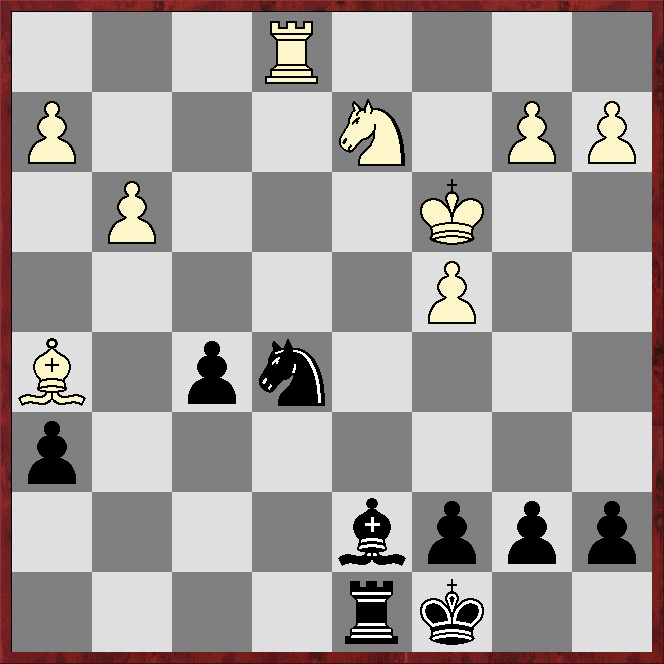English
1.c4 Nf6 2.Nc3 e6 3.e4!?
This is a well-known way to prevent Black playing a Nimzo-Indian or a regular Queen's Gambit Declined.
 |
| This position occurs 13,848 times in ChessBase's 2025 Mega database, but what should White's system be called? |
*****
*****
*****
*****
I understood it to be the Mikėnas-Flohr System, named after Vladas Mikėnas, who could be variously described as Estonian, Lithuanian and Soviet Russian, and Salo Flohr, who had claims to be Austrian, Polish, Ukrainian, Czechoslovakian and Soviet Russian.
However Wikipedia's article on the English Opening five times refers to the variation as the Mikėnas-Carls, honouring Vladas Mikėnas and the German player Carl Carls.
To further confuse the issue, the same article also calls the variation the Flohr-Mikėnas Attack, albeit spelling Mikėnas without an accent (as also happens one time in Mikėnas-Carls).
There are 16 games in Mega25 in which Carls played 3.e4!?, compared with just three for Flohr (plus a further one in which Flohr had the black pieces) and 11 for Mikėnas (plus five for Mikėnas's son Alius).
From these numbers it could be argued that the fairest name is Carls-Mikėnas, especially as Carls seems to have been the first of the three to have played it.
On the other hand there is a long history of openings being named after the famous, rather than the originators, in which case perhaps Aron Nimzowitsch's name should be added to the list - he has six games with 3.e4!? in Mega25, including a 1931 win over Flohr.
If anyone has a definitive answer to the conundrum, I would be interested to learn it.
3...d5 4.e5
Carls usually played 4.cxd5, Flohr and Nimzowitsch preferred the text, Mikėnas (senior) began with 4.e5, but later in his career switched to 4.cxd5, and Mikenas (junior) plays 4.cxd5.
4...d4 5.exf6 dxc3 6.fxg7 cxd2+ 7.Bxd2 Bxg7 8.Qf3!?
This positional pawn sacrifice seems to a novelty. The main continuation is 8.Qc2.
*****
*****
*****
*****
8...Nc6!?
Stockfish17 and Dragon1 fluctuate between accepting the gambit and declining it with 8...Bd7!?
After 8...Bxb2, play might continue 9.Rb1 Qf6!? 10.Qb3!? Be5 11.Nf3 Nc6!? 12.Nxe5!? Qxe5+ 13.Qe3 Qxe3+ 14.Bxe3, when the engines reckon White's bishop-pair does not fully compensate for being a pawn down. However, both sides have plenty of alternative move along the way.
9.0-0-0 Qf6 10.Qxf6 Bxf6
 |
| With Black having (more-or-less) forced queens off the board, how would you assess the position? |
*****
*****
*****
*****
Black has an extra pawn-island, but has the only pawn on the central two files and has an actively placed dark-square bishop. The engines reckon the game is equal.
11.Nf3 Bd7 12.Bd3 0-0-0 13.Bg5!?
The engines reckon 13.Ng5 is well-met by 13...Ne5.
13...Bxg5+ 14.Nxg5 Ne5 15.Be2 h6 16.Ne4?!
This is probably a mistake, so 16.Nf3 or possible 16.Nh3!? should have been played.
16...Bc6 17.f3 Rhg8
After 17...Bxe4!? 18.fxe4 Black has a strong knight against a bad bishop. The engines also like 17...Rdg8!?, with ...Bxe4 to come, one point being 18.Ng3?! can be met by 18...h5.
18.Rhg1?
Better is 18.Ng3, or 18.Rxd8+ Kxd8 19.Ng3.
18...Rxd1+ 19.Kxd1 f5?
Missing the win of material by 19...Bxe4 20.fxe4 Rd8+ and 21...Rd4.
20.Nd2 Rd8 21.Kc2 Ng6 22.g3 Ne5
MS offered a draw.
*****
*****
*****
*****
White's better pawn-structure gives a slight edge, according to Dragon1, although Stockfish17 is not so sure.
23.Re1 Bd7
Not 23...Rxd2+? 24.Kxd2 Bxf3 as White, rather than losing to 25.Bxf3?? Nxf3+ etc, plays 25.Bd3, and after the forced 25...Nxd3 26.Kxd3 Black has virtually no chance of surviving the rook-v-bishop ending, despite starting it a pawn up.
24.f4 Nc6 25.Kc3 e5 26.fxe5 Nxe5 27.Bh5!?
*****
*****
*****
*****
27...Nc6?!
Probably better is 27...Ng4, not fearing 28.Bxg4.
28.Nf3 Rf8 29.Nd4?!
Almost certainly better is going straight after the f pawn with 29...Nh4.
29...Nxd4 30.Kxd4 Kd8
The engines point out 30...f4!? is possible, as 31.Rf1 can be met by 31...Rd8.
31.Ke5 Bc6?
Still possible is ...f4 as 31.gxf4?? blunders the white bishop to 31...Rf5+.
32.Rf1 Be4?
It seems there is no defence, eg the engines' 32...Be8 is simply met by 33.Bg4, after which the f pawn falls, but there would still be quite a bit of play before Black would be obliged to resign.
33.g4 Ke7 34.gxf5 Bd3?!
Or 34...Bc2 35.f6+ Kd7 36.Rf2 Bb1 37.Rd2+ Kc6 38.b4 with an advantage the engines reckon is worth much more than a rook.
35.f6+ Kd7 36.Rd1 1-0



No comments:
Post a Comment